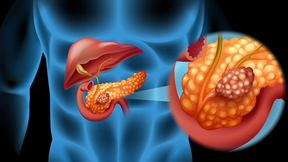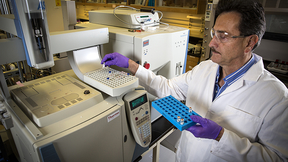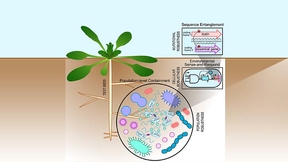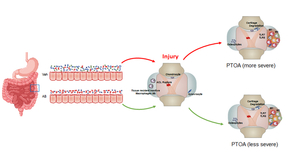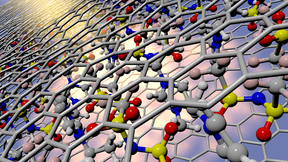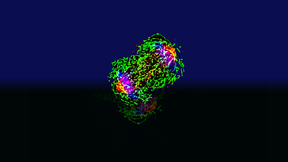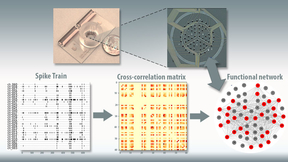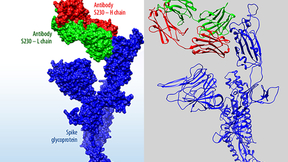Back
Biosciences and Biotechnology
LLNL weapon engineers, biologists deliver critical samples to identify skin proteins left on IEDs
Following a terrorist bombing, can the bomb maker be identified by skin proteins left on the bomb components they handled? To address this question, Lawrence Livermore National Laboratory (LLNL) personnel from Weapons Complex Integration (WCI) and Global Security (GS) Forensic Science and Biosecurity Centers (FSC/BSC) subjected notional bomb components handled by LLNL…
Lawrence Livermore’s popular lecture series goes virtual to cover COVID-19
Lawrence Livermore National Laboratory's (LLNL) popular lecture series, "Science on Saturday," is going virtual in 2021 with the theme “Combating COVID-19.” The series, targeted to middle and high school students, runs Saturdays at 10 a.m. Feb. 6 through Feb. 27. Each Saturday will feature a different lecture presented by leading Lawrence Livermore National Laboratory…
LLNL and United Kingdom company to collaborate on development of universal coronavirus vaccine
ConserV Bioscience Limited (CBL) and Lawrence Livermore National Laboratory (LLNL) have agreed to collaborate on the development of a broad-spectrum or “universal” coronavirus vaccine. This collaboration brings together CBL’s expertise in identifying antigens and LLNL’s nanolipoprotein delivery system. The vaccine has been designed to provide broad-spectrum protection…
Fast transport in carbon nanotube membranes could advance human health
Lawrence Livermore National Laboratory (LLNL) researchers have discovered that carbon nanotube membrane pores could enable ultra-rapid dialysis processes that would greatly reduce treatment time for hemodialysis patients. The ability to separate molecular constituents in complex solutions is crucial to many biological and man-made processes. One way is via the application…
Inhibiting protein in pancreatic tumors slows down cancer growth and increases survival rates
Georgetown University, Lawrence Livermore National Laboratory (LLNL) scientists and collaborators have identified a protein that when removed from the body may help pancreatic cancer patients live longer. Pancreatic cancer is one of the most lethal forms of the disease and has the lowest survival rate. Because the tumors are solid, many modern chemotherapies to destroy the…
The Worldwide Effort to Ban Chemical Weapons
The Forensic Science Center is an important ally in the international endeavor to prohibit chemical warfare agents.
Model for COVID-19 drug discovery a Gordon Bell finalist
A machine learning model developed by a team of Lawrence Livermore National Laboratory (LLNL) scientists to aid in COVID-19 drug discovery efforts is a finalist for the Gordon Bell Special Prize for High Performance Computing-Based COVID-19 Research. Using Sierra, the world’s third fastest supercomputer, LLNL scientists created a more accurate and efficient generative…
Tiny tubes come in big packages
Membrane-based systems have great potential as low energy alternatives in applications like desalination, pharmaceutical recovery, purification and waste treatment. Scientists at Lawrence Livermore National Laboratory (LLNL) have created the largest defect-free membranes reported to date that fully exploit the unique mass transport properties of carbon nanotubes as flow…
LLNL welcomes 'Ruby' supercomputer for national nuclear security mission and COVID-19 research
Lawrence Livermore National Laboratory (LLNL), along with partners Intel, Supermicro and Cornelis Networks, have deployed “Ruby,” a high performance computing (HPC) cluster that will perform functions for the National Nuclear Security Administration (NNSA) and support the Laboratory’s COVID-19 research. Funded by NNSA’s Advanced Simulation and Computing (ASC) program, the…
Building a secure biosystem to protect microorganisms
To reduce the risk of unintended ecological consequences from environmentally deployed, genetically engineered microorganisms (GEMS), Lawrence Livermore National Laboratory (LLNL) scientists and collaborators are developing built-in “security mechanisms” that ensure they function where and when needed. The team hopes to stabilize GEMs to prevent the transfer of potentially…
Corona supercomputer gets funding for COVID-19 work
With funding from the Coronavirus Aid, Relief and Economic Security (CARES) Act, Lawrence Livermore National Laboratory (LLNL), chipmaker AMD and information technology company Supermicro have upgraded the supercomputing cluster Corona, providing additional resources to scientists for COVID-19 drug discovery and vaccine research. The recent addition of nearly 1,000 AMD…
Antibiotic pre-treatment reduces joint inflammation
Tearing an anterior cruciate ligament (ACL) can be an excruciatingly painful injury. Nearly 50 percent of these patients will develop a secondary form of osteoarthritis, deemed post-traumatic osteoarthritis (PTOA). Researchers from Lawrence Livermore National Laboratory (LLNL) and the UC Davis Medical Center have found that treatment with antibiotics prior to the injury…
Lab earns 'A' grade in OPCW test
In another month-and-a-half, a score of chemists from Lawrence Livermore National Laboratory's Forensic Science Center (FSC) will start two weeks of long days to undertake the Organization for the Prohibition of Chemical Weapons (OPCW) environmental proficiency test. Livermore chemists have been taking the proficiency tests each October since 2001, with LLNL serving as one…
LLNL an OPCW-designated lab for biomedical samples
In addition to maintaining its Organization for the Prohibition of Chemical Weapons (OPCW) laboratory designation for analyzing suspect environmental samples, LLNL also is an OPCW-designated laboratory for the analysis of biomedical samples. (See "Lab earns 'A' in OPCW test) In this instance, OPCW inspectors have the ability to collect biomedical samples for cases of…
Neuronal cultures advance ‘brain-on-a-chip’ technology
Lawrence Livermore National Laboratory (LLNL) researchers have increased the complexity of neuronal cultures grown on microelectrode arrays, a key step toward more accurately reproducing the cellular composition of the human brain outside the body. As described in a recently published paper in Scientific Reports, an LLNL team led by biomedical scientist Heather Enright…
Diving into the structure of molten salts in tight spaces
Room temperature ionic liquids (ILs), a special class of molten salts, promise far greater electrochemical performance compared to conventional aqueous solutions due to a suite of novel and tunable properties. Over the past two decades, ILs have been explored as a means of improving a range of different technologies, from energy storage and conversion to catalysis to…
E-waste-eating protein extracts rare earth elements
Lawrence Livermore National Laboratory (LLNL) researchers, in collaboration with Pennsylvania State University (PSU) and Idaho National Laboratory (INL), have designed a new process, based on a naturally occurring protein, that could extract and purify rare earth elements (REE) from low-grade sources. It could offer a new avenue toward a more diversified and sustainable…
Signaling breast cancer metastasis
Metastasis accounts for approximately 90 percent of mortality in breast cancer patients. During the last few decades, there has been significant progress in understanding genetic, molecular and signaling mechanisms underpinning cancer cell migration. Biologists from Lawrence Livermore National Laboratory (LLNL) found another mechanism that affects the maintenance and…
Modeling neuronal cultures on 'brain-on-a-chip' devices
For the past several years, Lawrence Livermore National Laboratory (LLNL) scientists and engineers have made significant progress in development of a three-dimensional “brain-on-a-chip” device capable of recording neural activity of human brain cell cultures grown outside the body. Now, LLNL researchers have a way to computationally model the activity and structures of…
COVID-19 research goes public through new portal
To help accelerate discovery of therapeutic antibodies or antiviral drugs for SARS-CoV-2, the virus that causes COVID-19, Lawrence Livermore National Laboratory (LLNL) has launched a searchable data portal to share its COVID-19 research with scientists worldwide and the general public. The portal houses a wealth of data LLNL scientists have gathered from their ongoing…






